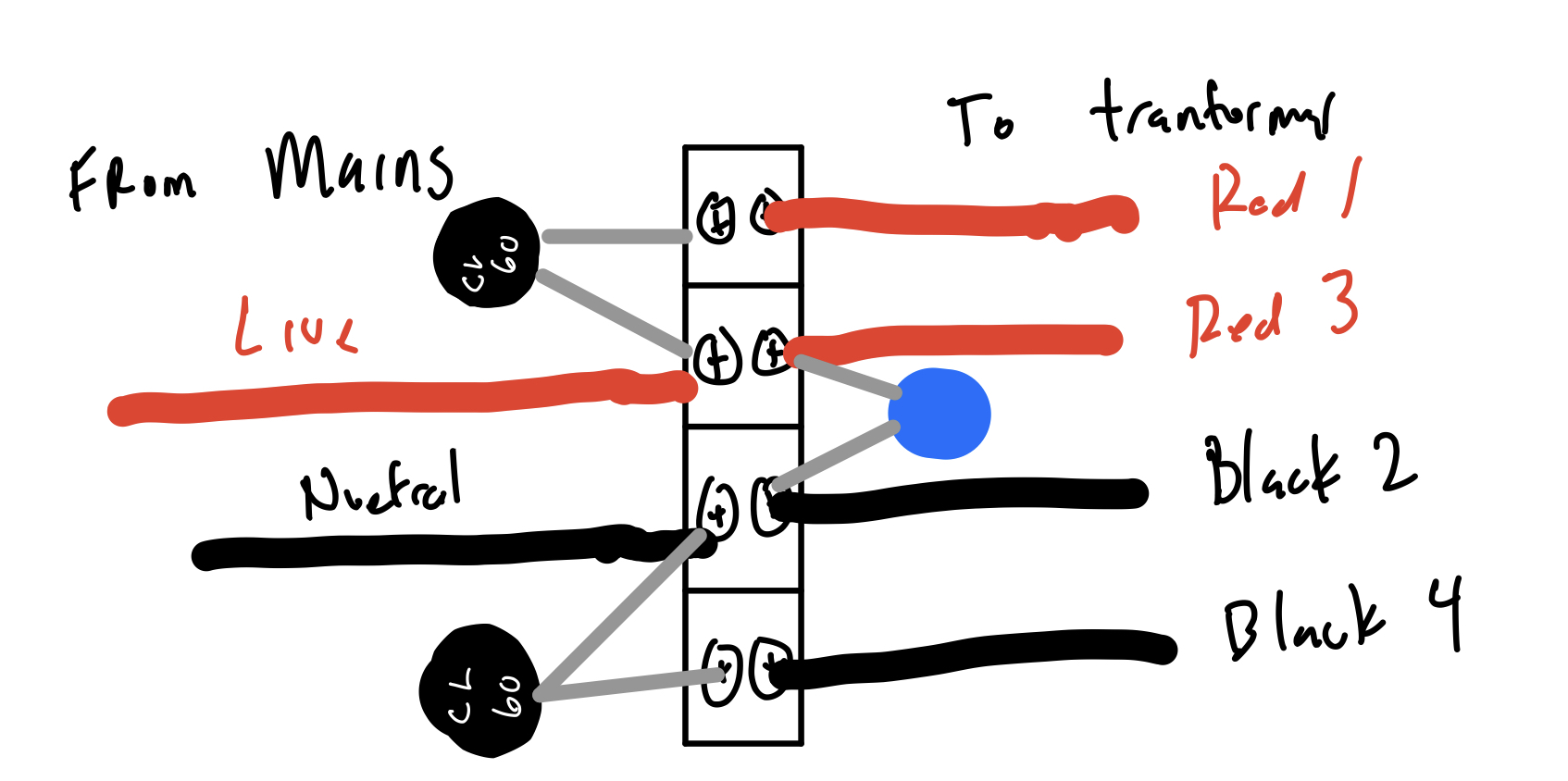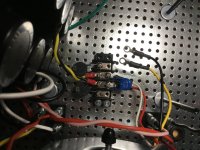Transformer is about 90 lbs. 40+ Kg for our friends across the pond.
Around 15lbs. each? I think. I've mounted the transformer and both chokes into the bottom of a small server cabinet with casters.1.2mH at 25 amps???? Holy moly!! What does that weigh?
Power will be limited by the 120V mains and the 5A variac. The main purpose of the supply is to bring my mosfet RF amp up to operating
voltage slowly so the bias can be set and may give it a little drive to make sure it's functioning okay. I have 2500W HP 50V switcher for regular operation.
Plan is to have jumpers for 2 separate supplies that can be configured in series parallel or a + 0 - setup. Good times!
I have this new transformer and I want to make sure I wire it correctly, I currently have an antek. The schematic shows each primary wire with a value.Has anyone used this transformer or have opinions on the companies quality in general?
https://toroid.com/wp-content/uploads/732.182-1.pdf
white 0V
Yellow 117V
Orange 0V
black 117V
The secondaries are labeled similarly, different colors, one lead is 0 and one is 18V.
The antek just shows one value for each pair.
I think it wires up the same way as long as you are using the pairs that go together or have continuity. Is that correct?
Looking at the spec sheet you linked above, on the primary side you want white with orange and yellow with black.
On the secondary side, brown-red go to one bridge rectifier and orange-yellow go to the other.
On the secondary side, brown-red go to one bridge rectifier and orange-yellow go to the other.
Are there cases like this that are long enough so everything lines up nicely on the bottom? The 4U cases are nice but it seems like there could be something that is a little longer but not as tall, to mimic the production model more closely.I think it's always a good education to see the layout on a factory amp.... I like where the rectifiers and transformer wiring lives here (with their big nasty current pulses), miles from anything else..
This thread is good for beginners, but as soon as you start asking questions (which is a great thing to do), you should check the main thread as well.
Here's something I posted earlier. It shows a layout that ensures very short wiring lengths in general, with a priority set to be:
1. Shortest DC rails and ground reference wiring between PS PCB and AMP PCBs
2. Very short mains wiring; CL60 soldered to IEC filter lugs using CL60's leads. The same goes for the primary winding wires - they are very short (less than 10cm) and are also soldered straight to the IEC filter lugs.
3. Secondary wiring twisted and sandwiched between two metal plates (transformer mounting plate and bottom plate)
4. (optional) PS PCB ground noise dumped to chassis using thick multistrand wire - no CL60 here. CL60 (especially with its long leads) would reduce the ability to dump the HF noise from PS to the chassis
Check this post for more details:
https://www.diyaudio.com/community/threads/aleph-j-illustrated-build-guide.241729/post-7276930

Here's something I posted earlier. It shows a layout that ensures very short wiring lengths in general, with a priority set to be:
1. Shortest DC rails and ground reference wiring between PS PCB and AMP PCBs
2. Very short mains wiring; CL60 soldered to IEC filter lugs using CL60's leads. The same goes for the primary winding wires - they are very short (less than 10cm) and are also soldered straight to the IEC filter lugs.
3. Secondary wiring twisted and sandwiched between two metal plates (transformer mounting plate and bottom plate)
4. (optional) PS PCB ground noise dumped to chassis using thick multistrand wire - no CL60 here. CL60 (especially with its long leads) would reduce the ability to dump the HF noise from PS to the chassis
Check this post for more details:
https://www.diyaudio.com/community/threads/aleph-j-illustrated-build-guide.241729/post-7276930
Last edited:
Hi,
I have a question about connecting the transformer.
I have 2 primary cables, not 4. What should I do?


I would like to use the snubber circuit with these recommendations :
Torroidy 500VA, 240V primary, dual 18V secondaries
Cx: 10nF
Cs: 150nF
Rs: 7Ω / 7Ω
Another question, I would like to add a switch. Is it possible to add this model? How to connect it?
THANKS !
I have a question about connecting the transformer.
I have 2 primary cables, not 4. What should I do?
I would like to use the snubber circuit with these recommendations :
Torroidy 500VA, 240V primary, dual 18V secondaries
Cx: 10nF
Cs: 150nF
Rs: 7Ω / 7Ω
Another question, I would like to add a switch. Is it possible to add this model? How to connect it?
THANKS !
^ You'll need to provide a little more information so that people can advise you how to safely build your power supply.
What are you planning to use to connect between the primary winding (the two white ends) and your mains connection (the power inlet module). To many, this is very simple, but if you are asking this question, I assume you have never done it before. Pictures of exactly what pieces you are using are very helpful.
Without pictures someone may just say... connect the primary with the NTC in series to your mains... and that may not be a very helpful answer.
re: the switch. It's best to save that for later. Current and voltage rating seem fine, but someone that has used that model or has more experience may advise.
I'll also assume you're on 230VAC mains in France.
What are you planning to use to connect between the primary winding (the two white ends) and your mains connection (the power inlet module). To many, this is very simple, but if you are asking this question, I assume you have never done it before. Pictures of exactly what pieces you are using are very helpful.
Without pictures someone may just say... connect the primary with the NTC in series to your mains... and that may not be a very helpful answer.
re: the switch. It's best to save that for later. Current and voltage rating seem fine, but someone that has used that model or has more experience may advise.
I'll also assume you're on 230VAC mains in France.
Thx.
230V oui.
In the Build Guide, I see that there are 4 connection points at the input of the transformer. I only have 2, how should I connect the transformer input?

This is an image from the build guide.
How should I put CL60 if I only have 2 inputs on the transformer?

230V oui.
In the Build Guide, I see that there are 4 connection points at the input of the transformer. I only have 2, how should I connect the transformer input?
This is an image from the build guide.
How should I put CL60 if I only have 2 inputs on the transformer?

- Home
- Amplifiers
- Pass Labs
- Aleph J build guide for noobs


 ... I'll wait till tomorrow.
... I'll wait till tomorrow.